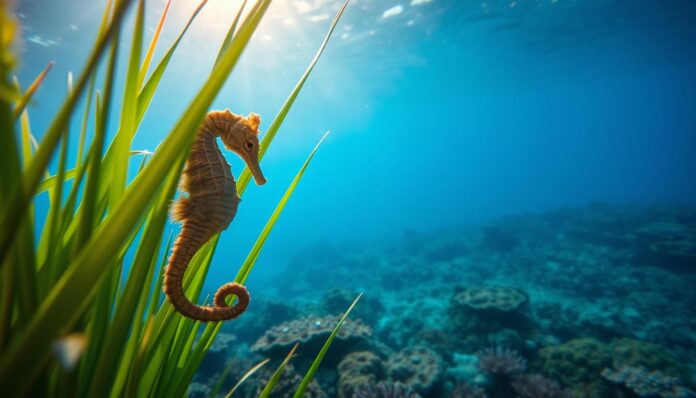Did you know that less than 1 in 1,000 juvenile seahorses survive to adulthood? These extraordinary marine creatures are a must-see for scuba diving fans worldwide.
Scuba diving with seahorses lets you see a magical underwater world. There are about 55 species globally. They range from tiny pygmy seahorses to long pot-bellied seahorses.
Protecting these delicate creatures is key. Underwater photography helps spread the word about their habitats and amazing abilities, like changing color fast for camouflage.
The Coral Triangle in Southeast Asia is a prime spot for seahorse sightings. Diving with seahorses teaches us patience and respect for marine life.
Key Takeaways – Diving with Seahorses
- Seahorses represent a unique and rare underwater diving experience
- Over 55 species exist worldwide with incredible size variations
- Marine conservation is critical for seahorse protection
- Underwater photography raises awareness about these marine creatures
- Southeast Asia offers prime locations for seahorse encounters
Introduction to Scuba Diving with Seahorses
Seahorses are truly magical creatures that fascinate divers and marine lovers. They are a special part of the marine world that needs our care and respect.
Exploring the world of seahorses is like entering a magical realm. Here, you’ll find incredible adaptations and mysteries of the sea. These creatures have unique features that make them stand out.
What Makes Seahorses Unique?
Seahorses are special in the underwater world because of their amazing features:
- They have an upright posture that looks like underwater plants
- They can change color to blend in perfectly
- They can move their eyes independently, seeing all around them
- They have a bony exoskeleton that protects their delicate body
The Importance of Seahorses in Ecosystems
Seahorses play a big role in marine ecosystems. They are important signs of ocean health and help keep the underwater world balanced.
| Seahorse Ecosystem Role | Impact |
|---|---|
| Food Chain Contribution | They are prey for bigger sea creatures |
| Habitat Indicator | They show how healthy the marine ecosystem is |
| Biodiversity Marker | They signal changes in the environment |
“Responsible diving practices are key to protecting these amazing creatures and their habitats.” – Marine Conservation Expert
If you want to dive with seahorses, it’s important to dive responsibly. This way, you won’t harm these delicate creatures and will have a memorable dive.
The Best Locations for Scuba Diving with Seahorses
Exploring the underwater world of seahorses is an incredible journey. It takes you through some of the most breathtaking marine ecosystems. Divers passionate about marine life can find these magical creatures in various global destinations.
Seahorses live in diverse marine environments. There are about 55 species found worldwide. Their adaptability lets them thrive in different underwater landscapes, from coral reefs to seagrass beds.
Top Diving Destinations for Seahorse Encounters
Marine enthusiasts seeking unforgettable snorkeling tours can explore several remarkable locations. These places are known for their seahorse populations:
Asia:
- Indonesia – The waters around Indonesia are home to a remarkable diversity of seahorse species. Locations such as Lembeh Strait, Bali, and Komodo National Park offer fantastic opportunities to encounter various seahorse species, including the iconic pygmy seahorses.
- Philippines – The Philippines boasts an abundance of seahorse hotspots. Destinations like Anilao, Dumaguete, and Puerto Galera provide excellent chances to observe numerous seahorse species amid stunning coral reefs and vibrant marine life.
- South Africa – Sodwana Bay, situated along the east coast of South Africa, is renowned for its diverse marine life and offers encounters with seahorses. The seagrass beds and reefs in this area are home to multiple seahorse species, providing a unique and memorable diving experience.
- Bonaire – Known as a diver’s paradise, Bonaire in the Dutch Caribbean offers seahorse encounters amid its pristine coral reefs. Klein Bonaire, a small uninhabited island just off the coast, is particularly renowned for its seahorse sightings.
- Utila, Honduras – The island of Utila in Honduras is a seahorse hotspot in the Caribbean. Divers can explore seagrass beds and coral reefs, encountering seahorses along with a rich diversity of marine life.
- Roatan, Honduras – With its vibrant coral reefs and diverse underwater ecosystems, Roatan is an excellent destination for seahorse enthusiasts. Sites like West End Wall and Mary’s Place are known for their seahorse sightings.
- Greece – The crystal-clear waters surrounding Greece provide a remarkable setting for seahorse encounters. Destinations like the Ionian Islands, Crete, and the Cyclades offer opportunities to spot seahorses while exploring the captivating Mediterranean marine life.
- Australia – Australia is home to a wide range of seahorse species. Locations like Sydney, Port Stephens, and the Great Barrier Reef offer exceptional diving experiences, with seahorses often found among the coral gardens and seagrass meadows.
- Florida, United States – Florida’s diverse underwater ecosystems, including the Florida Keys and the Gulf of Mexico, are known for seahorse sightings. Divers can explore seagrass beds, mangrove forests, and coral reefs in search of these elusive creatures.
- Ecuador – The Galapagos Islands in Ecuador are famous for their unique and diverse marine life. While exploring the archipelago’s stunning underwater world, divers may encounter various seahorse species alongside iconic marine species.
Please note that seahorse sightings can vary based on factors such as seasonality, water conditions, and the seahorse species’ specific habitat preferences. Consulting with local dive operators and experts can provide the most up-to-date information and increase your chances of successful seahorse encounters.
Plan your dives responsibly, respect the local environment, and adhere to diving regulations to ensure the preservation of seahorses and their habitats in these exceptional diving destinations.
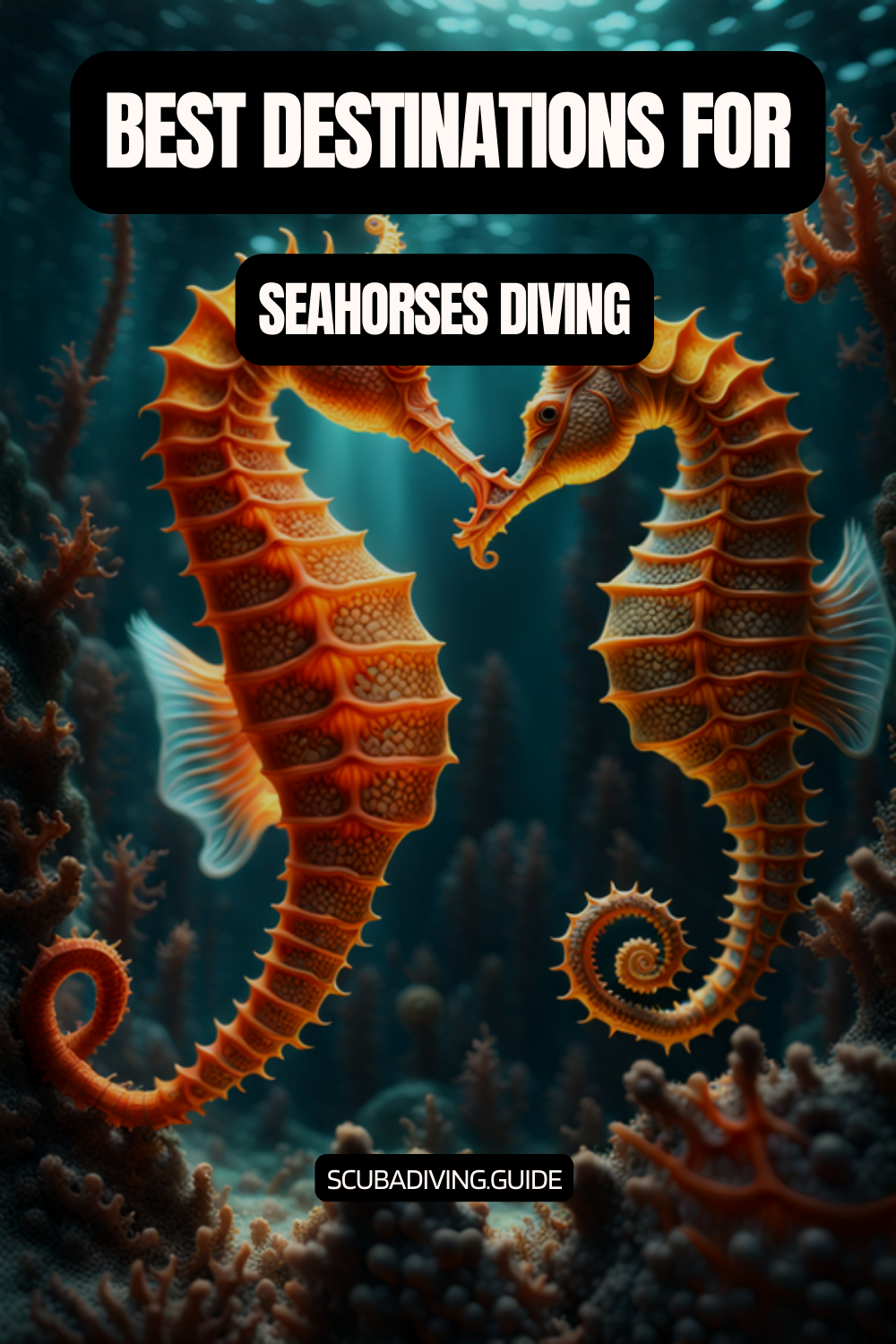
Diving Characteristics of Seahorse Habitats
| Location | Typical Depth | Seahorse Species |
|---|---|---|
| Indonesia | 10-20 meters | Barbigants Pygmy Seahorse |
| Thailand (Koh Lanta) | 15 meters | Tiger Tail Seahorse |
| Philippines | 5-30 meters | Multiple Species |
Eco-Tourism and Conservation
Responsible eco-tourism is key to protecting these delicate marine creatures. Divers should choose tour operators committed to sustainable practices and seahorse conservation.
“Every dive is an opportunity to appreciate and protect our marine ecosystems.” – Marine Conservation Expert
When planning your seahorse diving adventure, consider these key factors:
- Select small group dive tours
- Choose eco-friendly operators
- Respect marine habitat guidelines
- Support local conservation efforts
With careful planning and a respect for marine life, divers can enjoy magical encounters with these extraordinary creatures. This way, they support their preservation.
Preparing for Your Scuba Diving Adventure
Going on a scuba diving adventure with seahorses needs careful planning. It’s important to follow responsible diving practices. This ensures your safety and protects the marine environment.
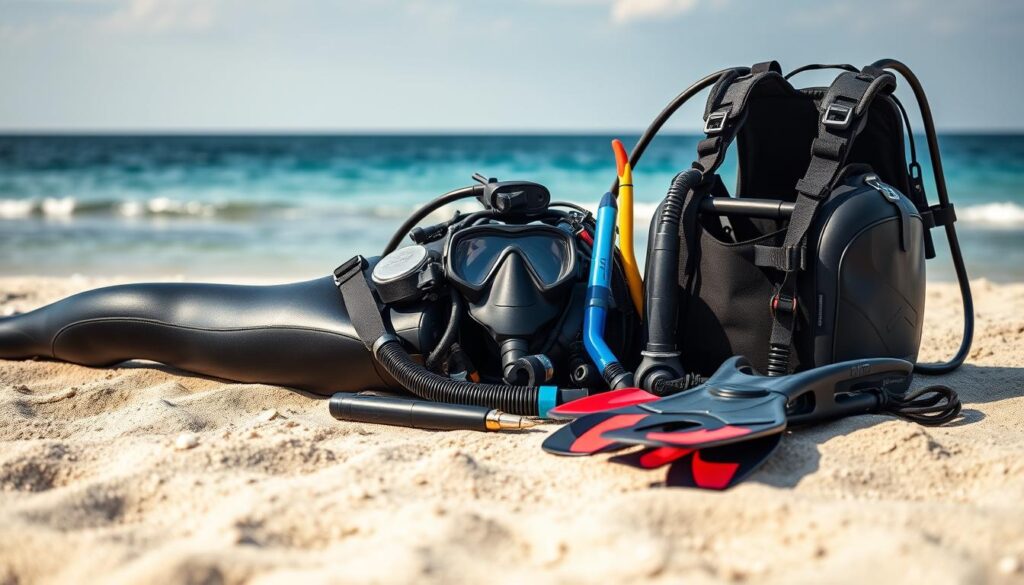
Essential Gear for Seahorse Diving
Choosing the right gear is key for a great scuba diving experience. Here are the must-haves for every diver:
- 3mm wetsuit for tropical waters (27°C to 29°C)
- Dive computer to track dive parameters
- Underwater magnifying glass for seahorse observation
- Neutral buoyancy control device
- Dive mask with anti-fog coating
Pre-Dive Safety Checks
Safety is the top priority when diving. Follow these steps for a safe and fun dive:
- Complete a detailed medical questionnaire
- Check your dive certification with the operator
- Make sure all your diving gear is in good shape
- Always dive with a buddy
- Learn and use hand signals and emergency procedures
“Preparation is the key to an unforgettable underwater adventure.” – Marine Biology Experts
| Dive Preparation Checklist | Recommended Action |
|---|---|
| Hydration | Drink water before diving, avoid dehydration |
| Medication | Bring seasickness pills and rehydration salts |
| Insurance | Get dive and travel insurance (DAN recommended) |
| Documentation | Carry a valid passport with 6+ months validity |
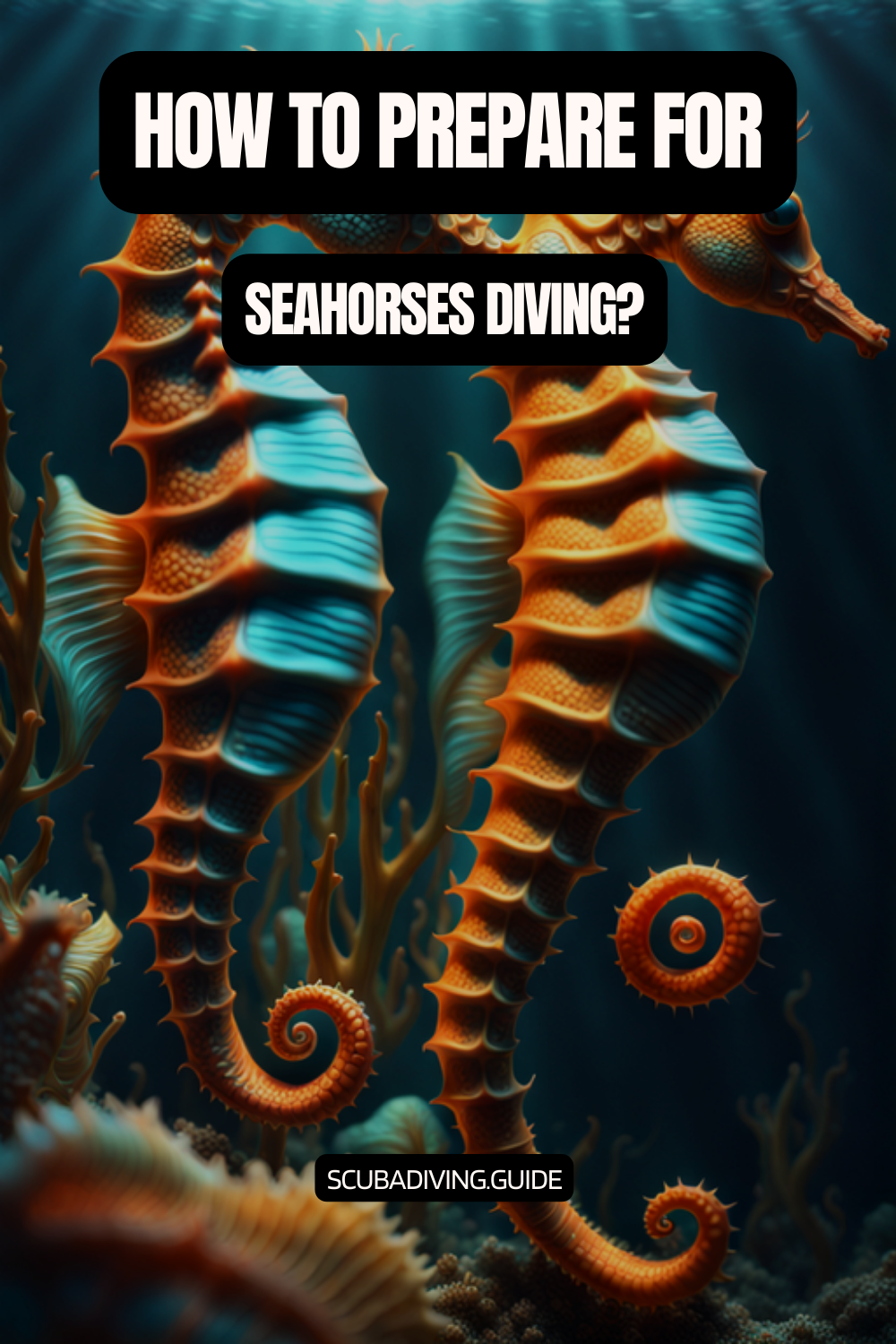
By following these tips, divers can have a better scuba diving with seahorses experience. It also helps protect the marine habitats.
What to Expect During a Scuba Diving Trip
Getting ready for a seahorse diving adventure means knowing about these magical sea creatures and their homes. You’ll have a unique underwater experience. It’s important to observe carefully and dive responsibly.
The dive conditions are key for your underwater journey. Seahorses live in places with:
- Water temperatures around 80-87 degrees Fahrenheit
- Visibility ranging from 60-70 feet
- Minimal to no water current
- Depths between 10-20 meters
Dive Duration and Expectations
Seahorse diving trips usually last 45-60 minutes. In this time, you’ll see these amazing creatures in their natural homes. The Tiger Tail Seahorse, for example, is mostly active at night and stays in the same place. They are great to watch underwater.
Interaction Guidelines with Seahorses
“Observe, but never disturb” is the golden rule of responsible diving with seahorses.
When you’re in seahorse habitats, you must follow strict rules:
- Maintain a safe distance of at least 3-4 feet
- Avoid touching or chasing seahorses
- Move slowly and deliberately
- Use minimal lighting to prevent stress
- Never attempt to collect or remove seahorses
By diving responsibly, you’ll help protect these delicate sea creatures. And you’ll have an unforgettable time underwater.
The Experience of Diving with Seahorses
Underwater photography fans and marine life enthusiasts find seahorses captivating. With 45 different seahorse species, every dive is a chance to see these magical creatures up close.
Diving with seahorses lets you see their amazing behaviors in their home. These tiny wonders are experts at hiding, blending with coral and seagrass.
Observing Seahorse Behavior in the Wild
Seahorses have traits that make watching them underwater special:
- Most seahorse species stay in the same spot for months.
- They are mostly active at night.
- Seahorses usually live in pairs and have small territories.
Capturing the Moments: Photography Tips
Photographing seahorses underwater needs patience and special skills:
- Use a macro lens for close-up shots.
- Adjust your camera for the low light underwater.
- Keep a safe distance to not scare them away.
“Capturing a seahorse in its natural environment is like freezing a moment of underwater magic.” – Marine Photographer
| Seahorse Species | Typical Length | Habitat Depth |
|---|---|---|
| Tiger Tail Seahorse | 6-10 cm | 10-20 meters |
| Pygmy Seahorse | 1-2 cm | 15-40 meters |
Remember, taking photos of seahorses underwater is an art. It requires respect for these delicate creatures and their homes.
Conservation of Seahorses and Their Habitats
Seahorses face big challenges in the ocean. Their numbers are dropping fast because of humans and changes in the environment. It’s very important to protect these special sea animals.
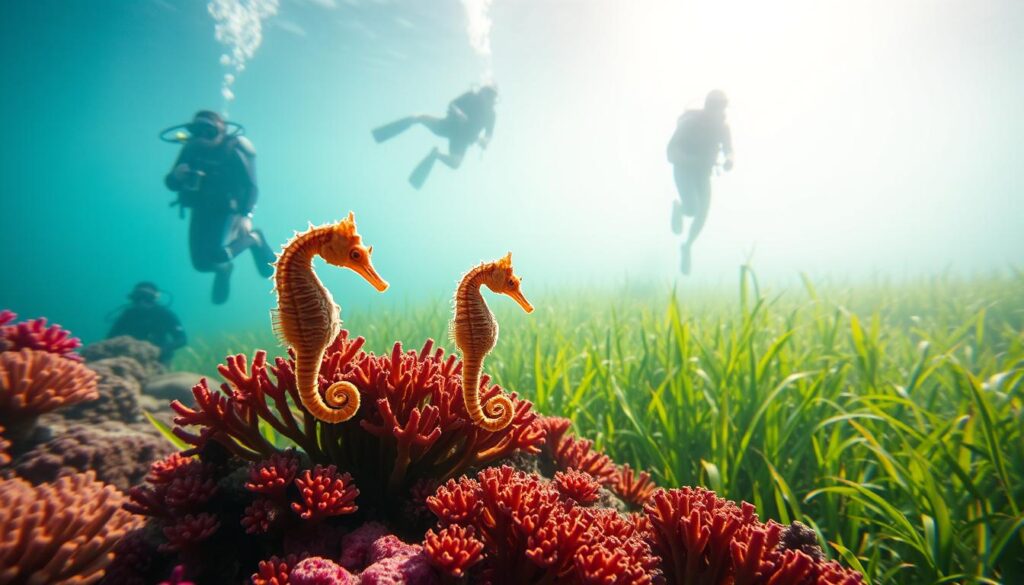
The world’s seahorses are under attack from many dangers. Marine experts and divers need to act fast to save them.
Threats Facing Seahorses Today
- Habitat destruction in coral reef systems
- Overfishing for traditional medicine markets
- Aquarium trade capturing wild populations
- Climate change impacts on marine ecosystems
- Coral diseases like Stony Coral Tissue Loss Disease
How Divers Can Help Protect Seahorses
Divers can make a big difference in saving seahorses. They help keep the ocean safe for these delicate creatures.
- Join citizen science projects to monitor seahorses
- Don’t touch or disturb their homes
- Support groups that protect the sea
- Tell others about the need to protect seahorses
- Teach other divers about how to help
| Seahorse Species | Conservation Status |
|---|---|
| Syngnathus watermeyeri | Critically Endangered |
| Hippocampus capensis | Endangered |
| Hippocampus kuda | Vulnerable |
“Protecting seahorses is not just about saving a single species, but preserving entire marine ecosystems.” – Marine Conservation Expert
The Coral Triangle is very important for seahorses. It’s in Indonesia, Papua New Guinea, and the Philippines. Underwater surveys and population monitoring help us understand and protect these amazing animals.
Training and Certification for Scuba Diving
Scuba diving with seahorses needs the right training and certification. Knowing the best courses can make your underwater journey better. It also helps you dive responsibly.
Courses for Beginners
Starting your underwater adventure begins with basic training. The SSI Scuba Diver program is a great start for those new to diving:
- Minimum age: 10 years old
- Total training duration: 10-16 hours
- Academic sessions: 3
- Pool/confined water sessions: 2
- Open water sessions: 2
- Maximum training depth: 12 meters (40 feet)
Advanced Diving Certifications
If you love diving with seahorses, getting special certifications can make a big difference. PADI has courses that teach you more about marine life:
| Specialty Course | Focus Area | Key Benefits |
|---|---|---|
| Peak Performance Buoyancy | Underwater Movement | Improved control, reduced environmental impact |
| Underwater Naturalist | Marine Life Identification | Enhanced marine ecosystem understanding |
| Seahorse Specialty | Marine Conservation | Specialized knowledge of seahorse habitats |
“Proper training transforms diving from an activity into an art of marine exploration.” – Marine Biology Expert
Learning to dive responsibly starts with good education. Each certification boosts your skills and helps protect the sea. Learning is key to enjoying your dives.
Health Benefits of Scuba Diving
Scuba diving with seahorses is more than just an underwater adventure. It’s a journey that boosts both physical and mental health. Exploring the marine world can be a transformative experience of wellness and eco-tourism.
Physical Fitness Advantages
Scuba diving is a full-body workout that works many muscles. Studies show it’s as good as swimming for your body. It’s a mix of aerobic and anaerobic exercise with little strain on your joints.
- Improves cardiovascular fitness
- Enhances muscular strength
- Increases overall endurance
- Burns calories through underwater movement
Mental Wellbeing and Stress Relief
The underwater world of scuba diving with seahorses is therapeutic. It offers a unique space for mental health improvement. Breathing techniques and being in marine ecosystems help a lot.
“Diving is not just an adventure, it’s a path to inner peace and wellness.”
| Health Benefit | Impact |
|---|---|
| Stress Reduction | Promotes mindfulness and relaxation |
| Breathing Control | Improves lung capacity and reduces anxiety |
| Social Interaction | Builds confidence and community connections |
Eco-tourism through scuba diving supports marine conservation and boosts personal well-being. Connecting with underwater ecosystems, like seahorse habitats, offers mental and physical rejuvenation.
Personal Stories from Scuba Divers
Scuba diving with seahorses opens a magical window into the underwater world. Divers share stories that show the beauty of marine exploration and underwater photography.
Our diving community has seen amazing moments with seahorses. At Square Rock, divers found at least 6 different seahorses during a night dive. These moments are unforgettable.
Memorable Encounters with Seahorses
Underwater photographers have caught incredible moments with seahorses. These delicate creatures, part of the Hippocampus family with 46 known species, offer endless fascination for marine enthusiasts.
- Witnessing seahorses in their natural habitat
- Capturing rare moments of seahorse behavior
- Understanding the challenges of marine conservation
“Every dive is a chance to connect with the ocean’s most remarkable inhabitants.” – Marine Biologist
Lessons Learned Beneath the Waves
Scuba diving with seahorses teaches us patience and respect for marine life. We learn about the importance of conservation. These incredible creatures can have up to 1,500 babies at once but face big environmental challenges.
| Seahorse Species | Conservation Status | Maximum Size |
|---|---|---|
| Lined Seahorse | Not Threatened | 6 inches (15 cm) |
| Dwarf Seahorse | Vulnerable | 1 inch (2.5 cm) |
| Longsnout Seahorse | Endangered | 17.5 cm |
Every dive is a chance to learn about marine ecosystems. It shows us the importance of underwater photography in conservation.
Planning Your Dive Trip
Planning a seahorse diving adventure needs careful thought and preparation. Whether you’re into eco-tourism or want to see unique seahorse habitats, this guide will help you plan the perfect dive.
Best Times to Dive with Seahorses
When planning snorkeling tours for seahorse sightings, timing is key. Different places offer great opportunities at different times:
- Southeast Asia: November to April (dry season)
- Caribbean: December to April (best visibility)
- Australia: June to September (winter)
Budgeting for Your Scuba Adventure
Having a detailed budget helps make your diving trip smooth. Here are some costs to consider:
- Dive equipment rental: $50-$150 per day
- Guided tours in seahorse habitats: $75-$250
- Accommodation near dive sites: $50-$300 per night
- Travel insurance with dive coverage: $30-$100
“The ocean is a magical world waiting to be explored, one dive at a time.” – Marine Biologist
Dive centers in places like Thailand and the Caribbean offer good deals. Koh Tao, Thailand, is known for its affordable diving courses, with some of the best rental prices around.
Pro Tips for Dive Trip Planning
- Research marine protected areas
- Check visa requirements
- Book eco-friendly tour operators
- Pack the right underwater photography gear
For a successful seahorse diving trip, plan well, respect the sea, and be adventurous.
Common Marine Species Found Alongside Seahorses
When diving with seahorses, you’ll likely encounter a diverse array of marine species that share their habitats. These cohabiting creatures contribute to the richness and biodiversity of the underwater ecosystem. Let’s explore some of the common marine species you may encounter alongside seahorses:
- Pipefish: Pipefish are close relatives of seahorses, sharing similar elongated bodies and snout-like mouths. They often inhabit the same habitats as seahorses and exhibit fascinating behaviors and intricate color patterns. Observing pipefish alongside seahorses provides a deeper understanding of the Syngnathidae family.
- Clownfish: Known for their vibrant colors and symbiotic relationship with anemones, clownfish add a delightful touch to seahorse dive sites. These small, territorial fish can be found darting in and out of the anemones, providing a vibrant and captivating spectacle.
- Shrimp and Crabs: The seafloor where seahorses dwell is teeming with life, including various species of shrimp and crabs. These crustaceans scuttle across the sand or seek shelter in crevices, adding movement and intrigue to the seahorse’s habitat.
- Cuttlefish and Squid: The graceful movements of cuttlefish and squid captivate divers as they glide through the water. Their ability to change colors and display intricate patterns adds a touch of mesmerizing beauty to the underwater scenery alongside seahorses.
- Nudibranchs: Nudibranchs, or sea slugs, are a favorite among underwater photographers for their striking colors and elaborate forms. These beautiful creatures come in an astonishing variety of shapes, sizes, and patterns, making them a captivating sight alongside seahorses.
- Eels: Moray eels and other types of eels often share the same habitats as seahorses. Their elongated bodies, sharp teeth, and mesmerizing movements create an intriguing contrast to the delicate appearance of seahorses.
- Sea Stars: Graceful sea stars, also known as starfish, are commonly found near seahorses. Their vibrant colors and intricate patterns make them a captivating sight, adding a splash of vivid beauty to the underwater landscape.
- Anemones and Corals: Colorful anemones and corals serve as important habitats and sources of food for various marine species. These delicate structures create a stunning backdrop for seahorses, providing both shelter and sustenance for the ecosystem.
- Schooling Fish: Schools of fish, such as damselfish, fusiliers, or anthias, often populate the same areas as seahorses. The synchronized movements of these shimmering shoals create a dynamic and awe-inspiring sight alongside the enchanting seahorses.
- Invertebrates: In addition to the more conspicuous species, countless invertebrates contribute to the biodiversity of seahorse habitats. From tiny sea worms and sea cucumbers to delicate sea fans and sponges, these often-overlooked organisms play vital roles in maintaining the health and balance of the underwater ecosystem.
Encountering these diverse marine species alongside seahorses enriches the diving experience, offering glimpses into the intricate interconnectedness of life underwater. Appreciating the entire ecosystem allows divers to develop a deeper appreciation for the delicate balance and importance of conservation efforts.
Conclusion: Embrace the Magic of Diving with Seahorses
Scuba diving with seahorses opens a special window into marine life. It shows us the importance of protecting our oceans. Every dive is a chance to see the beauty of seahorses in their home.
Marine conservation starts with understanding and caring for our oceans. Seahorses, hidden in coral and seagrass, show us the amazing diversity of sea life. When diving, remember to observe gently and disturb as little as possible.
Divers can help protect seahorses by diving responsibly. This means staying buoyant, not touching sea creatures, and sharing what we learn. From the deep waters of Richelieu Rock to the world’s oceans, every dive helps us learn and protect the sea.
Encouragement to Dive and Explore
Your underwater adventure is just starting. Whether in Thailand’s Andaman Sea or local spots, dive with curiosity and respect. Diving with seahorses is not just fun—it’s a chance to connect with nature’s wonders.
Final Tips for a Successful Dive
Be well-prepared, respect the sea, and be patient. The magic of seahorse encounters comes from diving with wonder and respect. Your efforts to protect marine life can make a big difference for future divers and sea lovers.
FAQ – Diving with Seahorses
What makes seahorses so unique for divers?
Seahorses are amazing marine animals with a horse-like head and the ability to change colors. They have a special way of reproducing, where males carry and give birth to the young. Their delicate nature and unique behavior make them a favorite among divers looking for extraordinary underwater experiences.
Where are the best locations for diving with seahorses?
Great places to dive with seahorses include Indonesia, the Philippines, and the Caribbean. Also, Bonaire and the Great Barrier Reef are known for their seahorse populations. These spots have well-protected marine areas that support diving and conservation.
What special equipment do I need for seahorse diving?
You’ll need underwater magnifying glasses, neutral buoyancy devices, and macro photography gear. Lightweight fins are also important to avoid disturbing the habitat. Use cameras with macro capabilities and good lighting to capture seahorses without stressing them.
How can I minimize my impact on seahorse habitats?
To dive responsibly, keep a safe distance and avoid touching seahorses. Move slowly and control your buoyancy well. Use minimal lighting and follow local conservation guidelines. Choose eco-friendly diving tours that protect marine ecosystems.
Are seahorses endangered?
Yes, many seahorse species are vulnerable due to habitat loss, climate change, overfishing, and the aquarium trade. Some populations have dropped by up to 50% in some areas. Conservation efforts are vital for their survival and the balance of marine ecosystems.
What certifications are recommended for seahorse diving?
Get Advanced Open Water, Advanced Buoyancy Control, Underwater Naturalist, and Marine Life Identification certifications. These help you observe marine life, dive with minimal impact, and understand complex ecosystems.
How can I contribute to seahorse conservation?
Support marine conservation groups, join citizen science projects, and choose eco-tourism operators. Spread the word about marine conservation and dive responsibly. These actions help protect seahorse habitats and reduce human impact.
What is the best time of year to dive with seahorses?
The best time varies by location, but calm, warm water with good visibility is key. In tropical areas, dive between November and April for stable conditions and better seahorse sightings.
How difficult is it to spot seahorses underwater?
Spotting seahorses is challenging because they blend in so well. They are nearly invisible to the untrained eye. Experienced guides and patience are essential for finding these camouflaged creatures.
What camera settings work best for seahorse photography?
Use macro lens settings, high shutter speeds, low ISO, and careful lighting for detailed photos. Choose subtle lighting and move slowly to avoid stressing these delicate creatures during your photoshoot.
